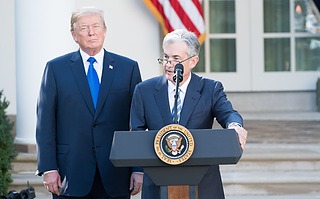Fed Quick Analysis: Dovish dots down dollar, why this may be a buy opportunity
Premium|
You have reached your limit of 5 free articles for this month.
Get all exclusive analysis, access our analysis and get Gold and signals alerts
Elevate your trading Journey.
UPGRADE- The Federal Reserve's dot plot is signaling zero hikes through 2023.
- Markets foresee such a lift-off coming already in early 2022.
- Chair Powell will likely push back against an early move.
- Markets will likely ease up on a dovish message.
- The dollar may temporarily soften before resuming its long-term uptrend.
Hold your horses – or at least just a bit. Only seven out of 17 Federal Open Markets Committee members foresee a rate hike in 2023 and only four in 2022. That is a dovish outcome in comparison to market pricing of the first increase in borrowing costs coming in 2022.
Follow all the Fed developments live
The dollar is falling and stocks are rising. What does this mean for markets?
Will Federal Reserve Chair Jerome Powell change the picture? Probably not, as while he refused to promise interventions in bond markets, the world's most powerful central banker has repeatedly stressed that the US economy is a long way to recovery. It is all about the unemployed – roughly 9.5 million people who have yet to return to their pre-pandemic jobs.
Stocks have been suffering from brutal moves in yields. If returns on safe debt from Uncle Sam are rising sharply, shares become rapidly less attractive. However, gradual upside moves are welcome as they reflect a return to pre-pandemic growth, which is positive for Wall Street companies.
The Fed's message is supportive of the latter – gradual moves that allow shares to move up in tandem with yields.
For the dollar, it is another story – a difference between the short term and the longer one. In the short term, the pushback against raising interest rates is adverse for the value of the dollar.
However, the Federal Reserve's support of the economy joins President Joe Biden's $1.9 trillion stimulus bill – with trillions in infrastructure coming. Moreover, America's vaccine campaign is also moving at a rapid clip,
All in all, the US economy is set to grow fast – something the Fed has acknowledged in another part of its dot plot – and the greenback is set to rise. It is essential to note that ten-year Treasury yields have quickly recovered from their downside knee-jerk move. It is around 1.65% at the time of writing.
Will the dollar remain low if the US economy and yields surge higher? Probably not.
- The Federal Reserve's dot plot is signaling zero hikes through 2023.
- Markets foresee such a lift-off coming already in early 2022.
- Chair Powell will likely push back against an early move.
- Markets will likely ease up on a dovish message.
- The dollar may temporarily soften before resuming its long-term uptrend.
Hold your horses – or at least just a bit. Only seven out of 17 Federal Open Markets Committee members foresee a rate hike in 2023 and only four in 2022. That is a dovish outcome in comparison to market pricing of the first increase in borrowing costs coming in 2022.
Follow all the Fed developments live
The dollar is falling and stocks are rising. What does this mean for markets?
Will Federal Reserve Chair Jerome Powell change the picture? Probably not, as while he refused to promise interventions in bond markets, the world's most powerful central banker has repeatedly stressed that the US economy is a long way to recovery. It is all about the unemployed – roughly 9.5 million people who have yet to return to their pre-pandemic jobs.
Stocks have been suffering from brutal moves in yields. If returns on safe debt from Uncle Sam are rising sharply, shares become rapidly less attractive. However, gradual upside moves are welcome as they reflect a return to pre-pandemic growth, which is positive for Wall Street companies.
The Fed's message is supportive of the latter – gradual moves that allow shares to move up in tandem with yields.
For the dollar, it is another story – a difference between the short term and the longer one. In the short term, the pushback against raising interest rates is adverse for the value of the dollar.
However, the Federal Reserve's support of the economy joins President Joe Biden's $1.9 trillion stimulus bill – with trillions in infrastructure coming. Moreover, America's vaccine campaign is also moving at a rapid clip,
All in all, the US economy is set to grow fast – something the Fed has acknowledged in another part of its dot plot – and the greenback is set to rise. It is essential to note that ten-year Treasury yields have quickly recovered from their downside knee-jerk move. It is around 1.65% at the time of writing.
Will the dollar remain low if the US economy and yields surge higher? Probably not.
Information on these pages contains forward-looking statements that involve risks and uncertainties. Markets and instruments profiled on this page are for informational purposes only and should not in any way come across as a recommendation to buy or sell in these assets. You should do your own thorough research before making any investment decisions. FXStreet does not in any way guarantee that this information is free from mistakes, errors, or material misstatements. It also does not guarantee that this information is of a timely nature. Investing in Open Markets involves a great deal of risk, including the loss of all or a portion of your investment, as well as emotional distress. All risks, losses and costs associated with investing, including total loss of principal, are your responsibility. The views and opinions expressed in this article are those of the authors and do not necessarily reflect the official policy or position of FXStreet nor its advertisers.